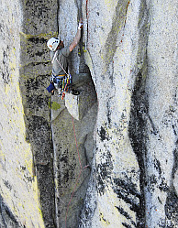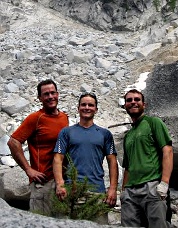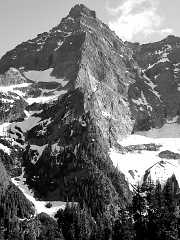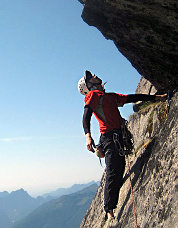|
|
||||||||||||
 |
|||||||||||||
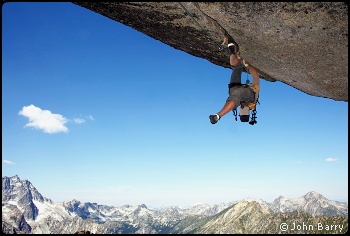 |
|||||||||||||
|
|||||||||||||
|
On July 22, 2009, Jens Holsten and I made the first free ascent of “Dragons of Eden” on Dragontail Peak. One year previously, armed with an online topo and motivating psyche from first ascensionist Wayne Wallace, we made the likely first repeat of the route and its first alpine-style ascent (using quite a bit of aid) in a 20 hour car-to-car adventure. Though very dirty, we were so impressed with the steep, physical, and challenging climbing of the route we became completely obsessed with freeing the line and spent the next year with DOE on our minds. We spent July 20 and 21 aiding, scrubbing, and working out the sequences of the crux pitches. On the 22nd, Jens had an impressive no-falls day, including leads of the crux 12- and 11+ final headwall pitch. I fell seconding both these pitches. The route saw at least two subsequent ascents later in the summer, with each party confirming the challenging and wild nature of the climbing. IV+ 5.12- -Sol Wertkin Mount Challenger, Middle and West Peaks, New Routes Inspired by views of rugged unclimbed ridges on the back side of the Northern Pickets during a 2008 trip, Mario Moreno, Sandy Weil, Keith Luther, and I returned in August 2009, this time with rock gear and dreams of new routes. I’d only taken a handful of photos in 2008 before a multi-day molasses-thick whiteout descended. Those images showed compelling unclimbed features, including the 1,100-ft south ridge of Middle Challenger. We had more than the usual pre-trip hand-wringing, with injuries, illnesses, family matters, road closures, and forecasts of thunderstorms. But on the evening of August 4 we were camped up at Middle Challenger col. On August 5, we descended from the col to the base of the ridge of the Middle Peak. The climb began at the toe with fun scrambling on the ridge crest. Several steps presented climbing to 5.7 on cracks and ramps. We drifted left of the crest as the climb became steeper, first scrambling 4th-class terrain, then belaying three pitches of fun mid-fifth class climbing back onto and up the crest. Soon we were on top, enjoying a dream realized. After a celebration and a good night’s sleep, our attention turned to West Challenger on August 6. From our camp, the East Ridge and Southeast face presented compelling views, with steep slabs split by cracks, set among outrageous scenery. We decided to give the East Ridge a go. After some discussion at the base, Mario and Sandy let Keith and me have a crack at it with the group’s two light rock racks combined into one more-sizable rack. I led a 5.7 pitch on blocks and slabs to the notch at the base of the ridge. The slab above looked inviting, like Castle Rock set in the Pickets. I followed perfect hand and finger cracks with occasional face moves, climbing higher and higher, wondering if the route would blank out. But it just kept going and a final fingertip traverse led to a belay on the ridge crest. I whooped with excitement. This 5.9 pitch would get three stars at any crag, even before factoring in the scenery. Keith led an airy traverse on the crest, followed by my leftward traverse and through some questionable blocks. Keith led up a clean gully, setting me up for a 5.9 sequence out of an alcove and up jumbled blocks to the summit ridge. With our lazy mid-day start, we were now running low on time. Our turn-around time was 6 p.m., and it was now 5:55! After summit Rolos, we set a rappel route down the East Face. Three double-rope rappels—the middle through a natural rock tunnel and the rope-stretching free hanging finale—took us back to our boots and good friends. It was a memorable way to spend my birthday so we named it the Birthday Route. -Seth Pollack Colchuck Balanced Rock, “The Scoop,” New Route On August 9, 2009, Evan Cabodi, Stewart Matthiesen, and I completed our new line, “The Scoop,” on Colchuck Balanced Rock. This was the culmination of two separate four-day trips to the Enchantments. The initial three pitches were climbed clean during a trip in June and consisted mostly of easier climbing with several short 5.10a cruxes distributed among the three pitches. These led to Launch Ledge below the namesake pitch. “The Scoop” is a 60-meter crack that looks like a giant used an oversize ice cream scoop to dig it out, creating a sharp dihedral at the bottom and slowly “scooping” into an overhang near the end. Since the crack was filled with black lichen, Stewart headed up with a full array of aid gear. To our surprise, as he cleaned out the lichen a beautiful finger/hand crack appeared that took fantastic gear the entire way. Over the next couple of days, we also completed pitches 5 and 6 using aid gear, cleaning out moss and dirt as we went. We planned to return in August to free the route when it was dry.
The August trip started much easier as we left the aid gear at home. On the first day, we were able to get to the base, set up camp, and climb the first three pitches to Launch Ledge. We nearly accomplished our goal for the trip on the second day, with Evan nearly sending the Scoop pitch on his first go, and Stewart and I freeing the remaining two pitches at 5.10b and 5.10a. At the top of pitch 6, all three of us tied together and simul-climbed the last several hundred feet to the summit. Evan successfully led the Scoop pitch the following day, freeing one of the best finger/hand cracks I’ve climbed in the Pacific Northwest. The route was climbed ground up, without the use of any fixed gear, and has been extensively cleaned. Using only natural anchors, it is possible to rappel the route using two 60-meter ropes. III+, 5.11c, Topo -Matthew Clifton Buck Mountain, North Ridge, Surprise Second Ascent
On August 10, 2009, Wayne Wallace and Jim Shokes climbed the North Ridge of Buck Mountain, hoping for a first ascent. They camped the night before the climb below and west of the ridge, above timberline. The following morning they crossed to the east side of the ridge and gained elevation via a steep, loose gully. Above the gully they bypassed the first two major towers on the ridge via talus and heather on the east side. Several leads brought them to the ridge crest and they climbed the intimidating third tower on its left side. Wallace described the 5.8 pitches on the tower as exposed with “earned pro” on solid rock. Ultimately they climbed to the hoof-shaped summit by passing between Buck’s “toes.” Wallace called this “a most spectacular finish to a worthwhile route.” Inspecting the summit register, the party found a 1976 entry by Mark Moore and Cal Folsom for the North Ridge (V, 5.8). The entry described the route as “a Cascade classic” with “aesthetic rating 1+”. This is apparently the route listed in Cascade Alpine Guide Volume 2 as the North Face. The CAG entry notes: “The climb proved to be extremely loose and dangerous—the party warned others to avoid this climb.” The disparity between the register entry and the guidebook notation remains unexplained. Mount Despair, SW Ridge, New Route
On August 17, 2009, Tim Halder and I climbed a new line on the SW Ridge of Mount Despair. The rock was of good quality at times, and the scenic position and wild character of the climbing was enjoyable. Incredible views of the Pickets and Mount Triumph gave inspiration to the often difficult cross-country travel, and few signs of human presence were detected. We were surprised to discover that no one had signed Despair’s historic summit register since our visit the previous summer. The route began on the rightmost of two arętes split by a shallow gully. The upper ridge was gained in a few leads on blocky terrain. The first gendarme was bypassed on the right side. The second gendarme, a prominent cockscomb feature visible on the ridgeline, was climbed via 5.8 cracks. A rappel off a block returned us to the ridge proper. Two more challenging leads on the left side of the crest brought us to exposed simul-climbing on the upper ridge. Beyond, the SW Ridge met the upper SE Face. The final portion of the ascent climbed the last step of the SE route. The line was climbed spontaneously, without the use of bolts or pitons, and from the ground up with Russian accents. II-III, 5.8 -Aaron Clifford Colchuck Balanced Rock, Tempest Wall, Free Ascent On August 30, 2009, Tom Ramier completed a free ascent of the Tempest Wall route on Colchuck Balanced Rock, calling it one of the most spectacular and unique climbs he’s ever done. The dramatic crux was the 25-foot, nearly horizontal hand-crack that splits the giant roof on the second pitch, which Ramier dubbed “Full Tilt.” Unlike Desert Gold and Separate Reality, two other famous roof cracks, Full Tilt has varied, traditional jamming moves over 25 feet, with a boulder problem at the lip. When contacted by the NWMJ editors, Ramier preferred to draw attention to the stellar quality of the route rather than to his own ascent, noting that a number of other strong climbers were attempting the route that summer and it could have been any one of them who finally freed the pitch. (The opening photo on this page shows Tom Ramier free-climbing the “Full Tilt” roof.) III+, 5.12c Sloan Peak, SW Face, “Fire on the Mountain,” New Route On August 30, 2009, Blake Herrington and I climbed what we believe is a new route on the steep, clean rock of the SW Face of Sloan Peak. We started in a prominent left-facing corner about 100ft right of a large diamond-shaped feature. I led the first pitch up a corner/chimney to striking vertical finger and hand cracks and a belay on a ledge (5.10+, 45m). Blake traversed right to a pair of hand cracks in a corner, ascended the right one, hand traversed right to a small stance, and linked face features and small cracks to a good ledge and a belay (33m, 5.10-). He continued up a thin crack and then moved onto a face with golden buckets, flakes, and edges, stopping under a gaping off-width roof crack (34m, 5.10-). “So how did you like the off-width on the West Face of CBR?” he asked. “Loved it,” I replied, “but I’m not going up that thing.” Instead, I hand traversed left under the roof, made delicate moves up a right-facing corner, and scampered up flakes and dikes to the giant ledge that bisects the face (40m, 5.8). It was a glorious sunny day in pristine alpine wilderness, but lots more steep, clean, featured rock loomed above us. Go time. Blake floated up a left-leaning crack system and a perfectly clean off-width corner to a belay on a pillar (45m, 5.9), where we found two old pins. From there, I led up a steep face peppered with protruding dikes and continued past an old pin in a steep finger crack/corner (45m, 5.10). On pitch 7, Blake led a 60m rope-stretcher to a stance just below another large ledge (63m, 5.7). Blake led the final pitch, which involved a hand crack around a roof bulge and a rising traverse on positive flakes to the final corner (45m, 5.10). We unroped and scrambled to the airy summit. We later learned that the pitons on pitches 5 and 6 were placed by a group that did not climb pitches 1-4. They placed the piton in the corner on pitch 6 on aid and did not reach the top of the wall. As sunset gave way to a calm, moonlit night, we followed the Corkscrew trail to the South Face descent, rapped to the sloping ledge and circled back to the trailhead. III+, 5.10+ -Rad Roberts The Roost, NE Face, “Fowl Play,” New Route On September 13, 2009, Rolf Larson and I climbed a new route on the NE Face of The Roost. From our bivouac, we started climbing just right of the indistinct rib in mid-face and ended just left of it. The first five pitches were brushy. The next four pitches were steeper and cleaner ‘terror-tainment’ that featured some steep, fun face-climbing protected in places by excavated cracks. Pitch 8 had the ‘5.9-ish’ crux. Above the nine belayed pitches, the route was completed by simul-climbing to the summit ridge. We joked that the route would “clean up nicely with a little traffic,” knowing that repeat ascents are unlikely. III, 5.9 -Eric Wehrly |
|
|
|||||||||||||||||||||||||||||||||||||||||||||||||||||||||||
| Continued << Previous | 1 | 2 | 3 | 4 | 5 | Next>> |
|||||||||||||||||||||||||||||||||||||||||||||||||||||||||||||
| ©2010 Northwest Mountaineering Journal | |||||||||||||||||||||||||||||||||||||||||||||||||||||||||||||
| Site design by Lowell Skoog |

